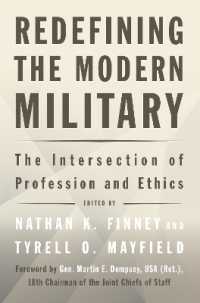- ホーム
- > 洋書
- > 英文書
- > Politics / International Relations
Full Description
Now in a fully revised and updated edition, this cogent book overviews the historical context and enduring patterns of US relations with Asia. Noted scholar Robert G. Sutter provides a balanced analysis of post-Cold War dynamics in Asia, which involve interrelated questions of security, economics, national identity, and regional institution building. He demonstrates how these critical concerns manifest a complex mix of realist, liberal, and constructivist tendencies that define the regional order. He describes how the United States has responded to Asia's growing strength and importance while at the same time trying to maintain its leading position as an Asian power despite China's rising influence. Considering the most important transition in American policy toward Asia since the end of the Cold War, Sutter assesses the growing US-China rivalry that now dominates regional dynamics in the Asia-Pacific and US policy in the region.
Contents
Acronyms
1 Introduction
2 Historical Lessons and the Evolution of U.S. Relations with the Asia-Pacific
3 Post-Cold War Developments
4 Asia, Obama's Rebalance, and the Ascendance of Donald Trump
5 Status and Outlook of U.S. Relations with China
6 U.S. Relations with Korea
7 U.S. Relations with Japan
8 U.S. Relations with Southeast Asia and the Pacific
9 U.S. Relations with South Asia
10 U.S. Relations with Central Asia, Mongolia, and Russia in Asia
11 China Rivalry, U.S. Leadership, and Asia's Contested Balance of Power
Selected Bibliography
About the Author






